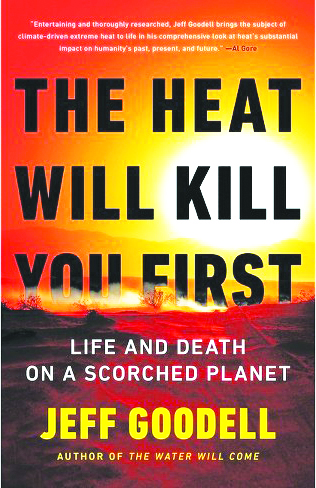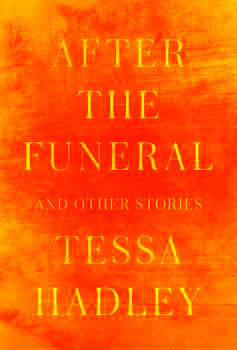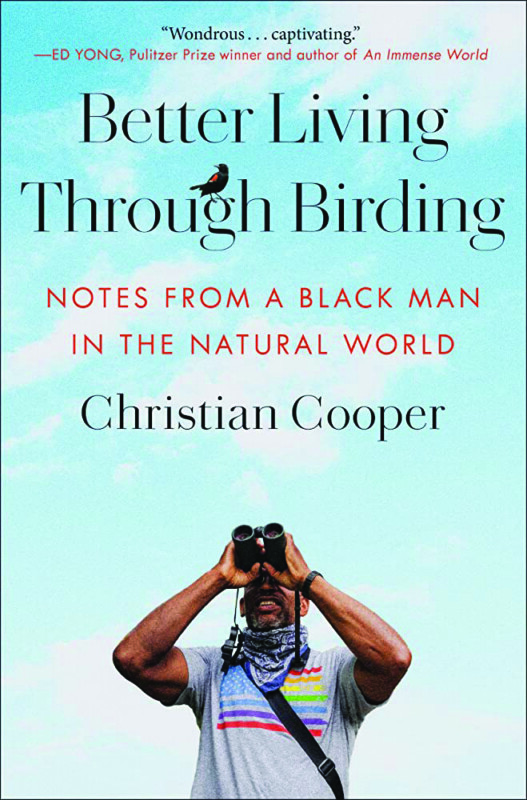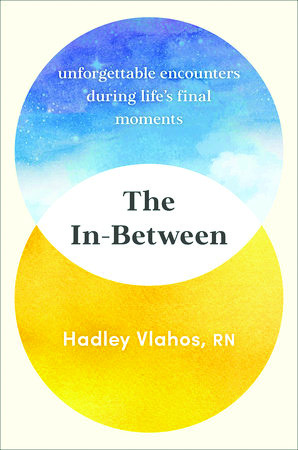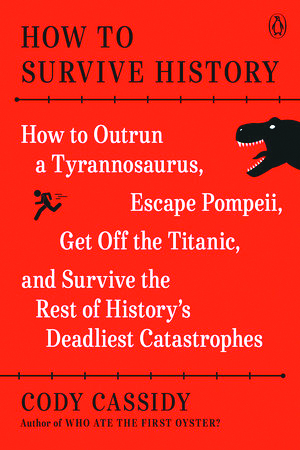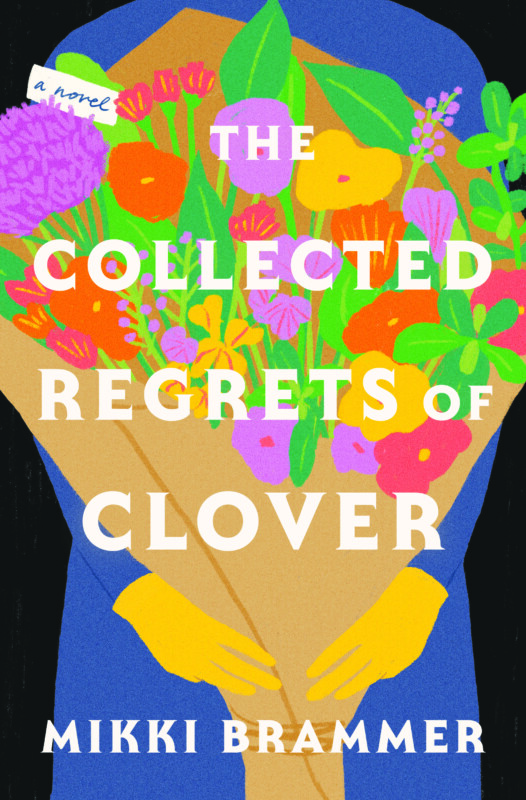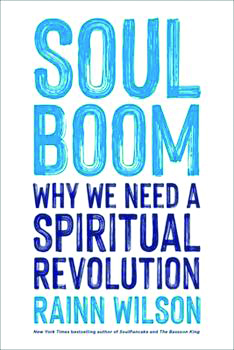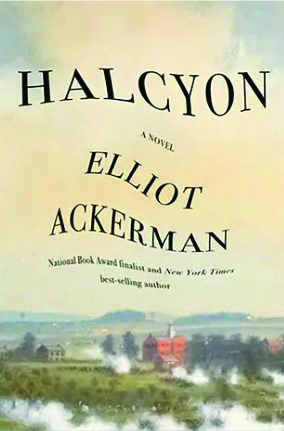The Heat Will Kill You First, by Jeff Goodell (Little, Brown and Co., 385 pages )
The effects of a warming planet seem less obvious in New England than in, say, Phoenix, Arizona, where it is 115 degrees Fahrenheit as I write. Except, of course, for the recently flooded towns in Vermont. And the hazy smoke that keeps drifting down here from Canada.
We can argue until the cows come home about whether we sit on the precipice of weather-driven, man-made calamity, but Jeff Goodell’s mind is made up. Heat, he says, is “an extinction force that takes the universe back to its messy beginnings. Before there was light, there was heat. It is the origin of all things and the end of all things.” And he is 100 percent certain about what is driving recent extreme weather: “250 years of hell-bent fuel consumption, which has filled the atmosphere with heat-trapping carbon dioxide.”
Goodell is a journalist who has been writing about climate for more than a decade. The cover of his 2017 book The Water Will Come looks like a still from a dystopian movie, with a trio of skyscrapers nearly submerged in seawater. Now Goodell is back with the equally alarming title The Heat Will Kill You First. His timing is impeccable.
Smart people on either side of the debate can disagree about whether recent record-setting heat waves are blips in time or a uniquely dangerous threat to humankind. But there’s no disputing that Goodell is an engaging writer at the top of his game. He’s like the love child of Ed Yong and James Patterson, with a little bit of Rachel Carson thrown in, which is to say he writes science-based, dystopian thrillers.
He acknowledges that small changes in global temperatures in recent centuries (overall, we’re up 2.2 degrees) don’t seem particularly scary. “Who can tell the difference between a 77-degree day and an 81-degree day?” he asks. … “Even the phrase ‘global warming’ sounds gentle and soothing, as if the most notable impact of burning fossil fuels will be better beach weather.”
But heat is deadlier than most of us think, he says. The human body is generally a well-regulated heat-generating machine, but it doesn’t take a whole lot of excess heat to kill us. Internally, there’s less than 10 degrees difference between our normal, everything’s-fine temperature of 98 degrees and the catastrophic cell death and organ failure that can occur at 107 degrees. And tragically, we get new examples of this almost every year when another fit athlete dies from heat stroke that occurs during a run or a football practice.
To drive this point home, Goodell recounts the story of the California couple who died with their baby and dog on an otherwise unremarkable day hike close to their home. The deaths, which made national news because they were originally so puzzling, were eventually determined to be from hyperthermia and dehydration. It had been in the 70s when they started the hike going downhill, but temperatures exceeded 100 on their way back up, and all appeared to have died of heat stroke.
“Just being alive generates heat. But if your body gets too hot too fast — it doesn’t matter if that heat comes from the outside on a hot day or the inside from a raging fever — you are in big trouble,” he writes. As our internal temperature rises past 103 degrees, blood pressure falls and people pass out. Interestingly, “This is in fact an involuntary survival mechanism, a way for your brain to get your body horizontal and get some blood to your head. At this point, if you get help and can cool down quickly, you can recover with little permanent damage.” But if you fall in a hot place and there is no one to help, you may never wake up.
Of course, people freeze to death when they fall unintended in cold places; falling and extreme temperatures are bad generally. But heat, Goodell says, is an “extinction force” and “the engine of planetary chaos, the invisible force that melts the ice sheets that will flood coastal cities around the world. It dries out the soil and sucks the moisture out of trees until they are ready to ignite. It revs up the bugs that eat the crops and thaws the permafrost that contains bacteria from the last ice age.” The next pandemic, he predicts, may come from some recently thawed ancient bacteria.
It’s not just humans at risk in extremely hot temperatures; others struggle in ways we normally wouldn’t think about. In the heat wave that hit Portland in 2021, for example, people were finding an unusually high number of injured baby birds on the ground. They weren’t dehydrated. They were leaving their hot, crowded nests before they were old enough to fly. And yes, dogs pant in heat since they can’t sweat like humans or plants, but some dogs fare better in heat than others, and not just because of differences in their fur. “Dogs with flat faces and wide skulls, such as English bulldogs, are twice as likely to succumb to heat as beagles, border collies and other breeds with more pronounced snouts.”
There is hardly a page without an odd, memorable fact like that, and a beautifully crafted paragraph that, as an added bonus, kindles a vapor of fear. Goodell, a longtime writer for Rolling Stone, is a pro at the dialogue-rich narrative style that keeps readers turning pages. Also, he’s really, really worried about us. From the sea creatures dying in warming oceans to deliverymen and farm workers passing out from heat stroke, he sounds the alarm on every page: you don’t know what is coming, you don’t know what is here.
In air-conditioned offices and homes, it can seem a bit overwrought, but, as he points out, there is a big divide between “the cool and the damned.” The affluent have central air conditioning while the poor swelter in homes without AC, or with old, inefficient units they can hardly afford to turn on. The disparity is worse in poorer countries. “Two hundred and twenty million people live in Pakistan, but there are fewer than a million air conditioners in the country,” Goodell writes. Economic inequality will be manifest in a “thermal gap,” he said, in which some people will fare better than others.
Goodell seems doubtful that things will improve; he notes that, were carbon emissions to cease today, carbon dioxide remains in the atmosphere for hundreds of years, but also acknowledges that human beings are adaptable and are already coming up with new ways to live; some cities, for example, are painting streets white to deflect heat. In other words, most of us can probably survive this — if the heat doesn’t kill us first. A

